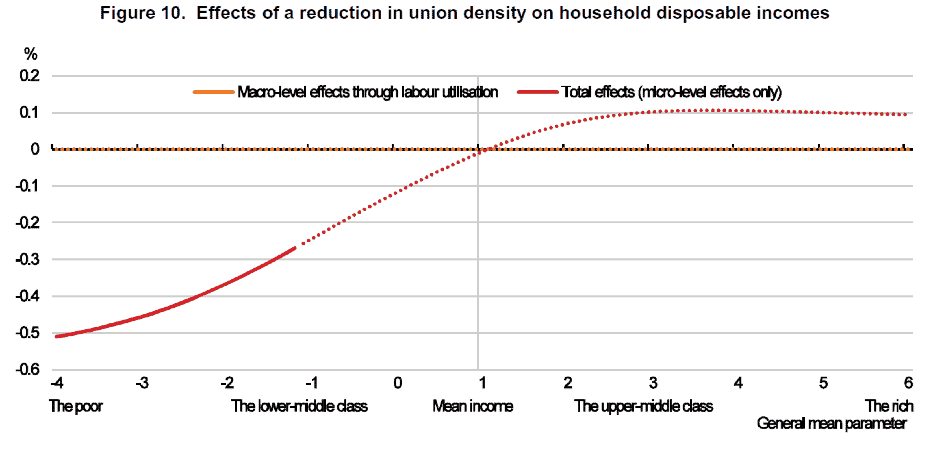
Worried by the populist backlash against globalisation, a big crowd of ministers, politicians and economists participated last June in the annual OECD week in Paris to discuss how to make globalisation work for everyone. While a multitude of panels and presentations stressed the benefits of economic openness and trade, the papers and publications which the OECD then launched also contain three critical messages.
Emerging doubts on the mainstream narrative
First, in its key issues paper for the Ministerial Council, the OECD recognizes that the frictional costs of opening to world trade have been much higher than so far assumed. Workers losing their job because of competition with low wage economies were supposed to find new jobs elsewhere and do so quickly because the same process of globalisation would be pushing up overall national income. The OECD now openly admits that this assumption was wrong. As the key issues paper (paragraph 37) says:
Some recent evidence suggests, however, that such losses have been more widespread, larger, more region-specific and more durable than previously realised.
This specifically refers to the research done by Autor et al. on the impact of trade with China on local labour markets in the US. This finds that adjustment is remarkably slow as wages remain depressed and local unemployment remains elevated even a full decade after the onset of the China trade shock. Moreover, displaced manufacturing workers are not the only ones to lose out as the negative shock spills over into wages and job losses in service industries serving the former manufacturing firms and their displaced workers. Local tax revenue goes down, public services get eroded and the life prospects of children in these communities worsen. In other words, ‘transitional’ costs turn out to be not so transitional after all.
A second critical stance is taken on what the OECD calls a ‘plausible’ link between globalisation and rising inequalities. Here, it explicitly admits that globalisation has weakened the bargaining power of labour in advanced economies, invoking the threat of cheap import competition from low wage countries as well as that of moving investment and production there. Weaker trade unions and weaker labour bargaining power in turn explain why real wage growth has been staying behind productivity dynamics and why the share of labour in national income has been going down in most economies over recent decades. As capital income is more unequally distributed than labour income, the falling labour share then pushes up overall inequality.
The latter argument is backed up by the OECD itself, finding that “the trend decline in the rate of unionisation experienced by many OECD countries over the last three decades is found to have contributed to the rise in income inequality” (see here box 3).
This conclusion comes from another OECD paper estimating the impact of several structural reforms on the disposable income of low, medium and high income households. The graph below illustrates what happens when trade union density declines. Whereas jobs performance does not improve in any way (in the graph, this comes under the heading of “macro-level effects through labour utilisation”), wages and thus the disposable income of poor and lower-middle class households go down,.
In other words, unions do not harm jobs but they do act as a force to reduce inequality by supporting wages of workers and households at the lower end of the distribution.

Finally, a paper published in April 2017 argues that the process by which trade deals are negotiated also matters. Trade and investment deals are often rushed through parliaments when all details have been negotiated, thus providing big business the opportunity to weigh on decision-making by massive lobbying of governments in the preceding trade negotiations themselves. The OECD specifically adds that ‘the cost-benefit balance of provisions such as ISDS look increasingly questionable, especially when both sides are advanced economies with low risk of discriminatory treatment of foreign investors and reliable judicial systems”. It would seem that the OECD is here at least joining the ranks of unions and their concerns about so-called trade agreements prioritising the rights and profits of corporations over the right of nations to legislate according to their own social, labour, health and environmental choices.
Making globalisation work for all by reducing minimum wages?
The OECD on occasions, however, regresses into a more ‘traditional’ point of view.
One such example can be found here where the OECD argues that the jobs disruption which is caused by trade needs to be addressed by a policy that promotes job creation; one way is to reduce minimum wages. The OECD does recognise that lowering minimum wages will reduce earnings but claims that the impact on total household income will be counteracted if the lower minimum wage allows for creating additional jobs among the low-skilled.
This latter claim depends on whether the minimum wage has such a negative impact on employment. However, just two years ago the OECD in its 2014 Employment Outlook concluded almost exactly the opposite by writing that ‘ the majority of studies suggest that the adverse employment effects of minimum wages tend to be small overall’.
Recently, interesting research using a new technique (a so called ‘bunching estimator’) that focuses on employment changes along the wage distribution after minimum wages hikes in US states between 1979 and 2016 again finds that the ‘overall employment effect of the minimum wage is likely to be close to zero’: The larger number of jobs that are paid at or slightly above the new minimum wage compensates for the jobs that pay wages below the increased minimum wage and which disappear.
Moreover, the way the discussion is framed by the OECD makes no sense. When workers are hit and displaced by trade shocks, the challenge is to enhance their job and income prospects. Getting them into jobs without any subsequent improvement in household incomes is not an answer as this simply prolongs the misery : More people at the bottom of the wage distribution may (or may not) be at work but all are working at a reduced minimum wage so that low income households on average are not better off than before. If anything, this actually worsens things as workers and their families are now having to work more in order to earn as much as before. The latter has been the experience of US households: Median household income was only 0.7 percent higher in 2014 than in 1989 but incomes at the bottom have only done as well because hours worked increased (See Stiglitz here).
Conclusion
Parts of the OECD are clearly opening up to the idea that the previous narrative of globalisation “lifting all boats” is overly simplistic and that there are real issues out there that urgently need a different approach. At the same time, and as the minimum wage example shows, old habits die hard and the temptation of reverting to the old agenda of labour market flexibility may not always be resisted by the OECD.
Ronald Janssen is senior economic adviser to the Trade Union Advisory Committee of the Organisation for Economic Co-operation and Development. He was formerly chief economist at the European Trade Union Confederation.

